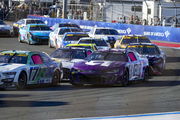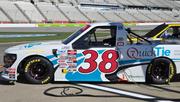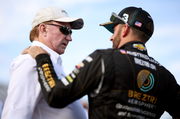
via Imago
Bowman Gray Stadium

via Imago
Bowman Gray Stadium
The Bowman Gray Stadium is one-of-a-kind. The quarter-mile track is the smallest venue to ever hold a NASCAR race, which may go on to explain why no Cup Series action has taken place at the short track since 1971. While NASCAR continues to grow and expand its horizons, with racing taking place at larger speedways, the Winston-Salem-based venue still shows signs of a bygone era, despite renovations being made ahead of ‘The Clash’.
For some of the older fans, the return to Bowman Gray Stadium is a cause for celebration. NASCAR has already proven that it can host races at quarter-mile tracks, with the last three Clash events taking place inside the Los Angeles Coliseum. Now, it’s time for the sport to return to its roots, and let the Cup Series experience the chaos of ‘The Madhouse’ all over again.
ADVERTISEMENT
Article continues below this ad
What is the Bowman Gray Stadium?
Located in Winston-Salem, North Carolina, Bowman Gray Stadium is a quarter-mile flat oval, widely regarded as one of the most legendary venues in the world of stock car racing. Often referred to as “NASCAR’s longest-running weekly race track”, the venue is known for its action-packed races and rowdy atmosphere, which has earned it the nickname, ‘The Madhouse’. Built in 1937, the overall track layout remains largely the same till date, which promotes close-quarters racing that adds to the overall unpredictability and drama of the races.
Bowman Gray Stadium can accommodate up to 17,000 spectators, giving fans an up close and personal view of the events taking place on the track. The venue is also home to Winston-Salem University’s Rams football team, and its multi-purpose functionality of a big part of the stadium’s longstanding legacy. Earlier, the surroundings near the track also featured yard lines, goalposts, and a scoreboard, which could only display the top three positions of the racers.
Richard Petty has won at the iconic track four times recalled his experience of racing while speaking to Greensboro (N.C.) News & Record years ago. He said, “By the end of the race, I was ‘Yards to Go,’ running third behind ‘Visitors,’ who was Bobby Isaac, and ‘Home,’ who was David Pearson. Visitors and Home were racing pretty good until I drove ol’ Yards to Go right by ’em and won the race.” Despite the renovations ahead of the Cook Out Clash, the Bowman Gray Stadium continues to give old-school NASCAR vibes, with its high-banked turns challenging drivers in every lap.
Looking back on the origin of Bowman Gray Stadium
Bowman Gray Stadium was built in 1937 as part of a Works Progress Administration (WPA) project, which was intended to give employment during the Great Depression. It was named after the former chairman of R. J. Reynolds Tobacco Company, whose family had played an integral role in its development. The first sporting event that took place at the venue was a football game between Wake Forest College and Duke University in 1938, after which it was also used for trotter horse racing on the 0.250-mile dirt oval.
However, it was not until 1939 that the venue was used for any type of motor racing, which ultimately led to the track getting paved in 1947. Eventually, it became the go-to venue for stock car racing, becoming NASCAR’s first weekly track, and the first paved surface where the organization held its races. The first NASCAR-sanctioned event took place in 1949, the same year the racing series was founded, and the Bowman Gray Stadium was officially opened by Bill France and Alvin Hawkins, whose family controls the venue even today.
What’s your perspective on:
Can the chaos of 'The Madhouse' bring back the thrill missing in modern NASCAR races?
Have an interesting take?
Trending
How did Bowman Gray become an integral part of NASCAR’s success story?
The Bowman Gray Stadium is an important part of NASCAR’s history as it helped the stock car racing series build a firm foundation to become the sport we know today. In its early days, the venue was a proving ground for promising racers, with drivers such as Richard Petty, Dale Earnhardt, and Junior Johnson making a name for themselves at the short track. By hosting weekly races, the stadium built a solid grassroots program which served as a breeding ground for talent that eventually progressed to NASCAR.

via Imago
Bowman Gray Stadium
The venue is a symbol of the sport’s short-track racing origins. In the last 88 years, the stadium has gone from being the birthplace of NASCAR to a thriving racing venue to a community hub, and its importance to the sports community is no less than what fans feel for Charlotte Motor Speedway or Daytona International Speedway. The sanctioning body has always had a foothold at the Bowman Gray Stadium, and the upcoming ‘Clash’ will be a ‘homecoming’ of sorts, the likes of which fans have not seen for 54 years.
What does it mean for the racing community as NASCAR reopens its doors to The Madhouse?
NASCAR’s return to the Bowman Gray Stadium is a significant moment for the racing community. Not only does it signify a return to the sport’s roots, but could potentially pave the way for other short-track venues, that have been overlooked by the sport to make a resurgent comeback. Short-track racing is the foundation that NASCAR has been built on, and for fans to experience the format in its raw form will be an experience in itself.
ADVERTISEMENT
Article continues below this ad
For drivers, it’s a chance to experience the quarter-mile oval, where countless NASCAR legends have raced before. It’s also their opportunity to reconnect with the sport’s history and test their skills on the track’s high-banked ovals, which will undoubtedly prove to be a challenging experience for even the most seasoned veterans. A successful preseason opener this year could potentially pave the way for NASCAR to feature the Bowman Gray Stadium permanently on the calendar. The possibilities are endless, and time will tell how much of an impact will the upcoming race have on the venue’s future.
Everything to know about NASCAR’s Clash at Bowman Gray Stadium
Racing at the Bowman Gray Stadium comes with its own set of limitations. As the track is too small to feature 39 cars at a time, all the entries will be split into three groups and each group will get two practice sessions of eight minutes each for track acclimatization. After that, each group will be further split into two more groups, allowing drivers to attempt their best lap time, which will help set the lineups for the heat races. A total of four heats will take place, three of which will feature 10 vehicles and one with nine cars and each session will have 25 laps.
ADVERTISEMENT
Article continues below this ad
Racers who finish in the top five in each heat will be eligible to compete at the pre-season opener, while the remaining 19 drivers will be competing in a separate 75-lap race on Sunday. The two cars that finish on top will also be eligible for the Cook Out Clash at Bowman Gray, and out of the 17 drivers left, the one with the most points from the 2024 Cup Series season will go on to occupy the final 23rd spot. The winner of the first and second Heat will occupy the first two spots and the main event will feature 200 laps with a halftime break in the middle.
As things stand, eight Cup Series drivers have experience competing on stock cars at the Bowman Gray Stadium. Chase Elliott, William Byron, Alex Bowman, Kyle Larson, Daniel Suárez, Cole Custer, Bubba Wallace, and Justin Haley will be optimistic about their chances at the pre-season opener, while others will also be aiming to give their best foot forward and gain some valuable momentum ahead of the upcoming season.
ADVERTISEMENT
ADVERTISEMENT
ADVERTISEMENT
ADVERTISEMENT







Can the chaos of 'The Madhouse' bring back the thrill missing in modern NASCAR races?